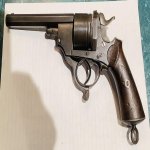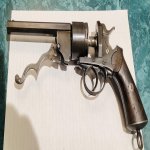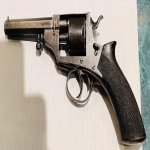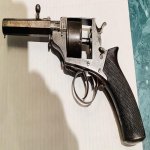You are using an out of date browser. It may not display this or other websites correctly.
You should upgrade or use an alternative browser.
You should upgrade or use an alternative browser.
Who likes weird guns?
- Thread starter snurge
- Start date
450 Adam's? Can you even find ammo for that? That is one strange looking rig.
It’s the same as.455
Haven’t shot it yet tho
vagrantviking
CGN Ultra frequent flyer
- Location
- High River, Alberta
Very interesting!
Like a Fangus or Merwin and Hulbert in some ways. Love odd things like that!
Like a Fangus or Merwin and Hulbert in some ways. Love odd things like that!
450 Adam's? Can you even find ammo for that?
It’s the same as.455
Haven’t shot it yet tho
Not the same as .455 ... but, despite their nomenclature, the two cartridges are actually the same caliber (... as, for that matter, is the ".476" Enfield cartridge.)
You can certainly make .450 cases from .455 cases ... either the Mk I or Mk II -

Big bore dinosaur
CGN frequent flyer
- Location
- NORT OF COW.TOWN.EH
Very cool guys
Enfields are very weird ,I’m surprised the military adopted them when regular top breaks were available.
Of course I want one.
The British War Department adopted it because they specifically requested it be designed and developed at Royal Small Arms Factory Enfield ... and it seems they got precisely what they asked for, but no more!
The solid-frame Adams revolvers which preceded the Enfield had to be loaded and unloaded one cartridge at a time through a loading gate (like a Single Action Colt) and had an extraction rod to facilitate pushing spent cases from the chamber. Wanting a more efficient handgun, the War Department tasked Enfield with designing a "self-extracting" metallic cartridge revolver, and the rather "Rube Goldberg-ish" Enfield was the result. It does break open and extract all cartridges at one time (as seen in my photo above) but instead of having an extractor star which pushes the cases out of the chambers, like we are used to nowadays, the extractor star remains fixed on the axis pin back by the recoil shield, and the cylinder is drawn forward while the cartridge cases stay behind ... and supposedly only the empty cases come clear of the chamber mouths to fall away.

However, the revolver must then be closed back up before re-loading ... which still involves inserting the cartridges into empty chambers one at a time through a loading gate! This arrangement, meant for keeping unfired cartridges in the cylinder so only expended rounds need to be replaced, is in fact a disaster waiting to happen: the case rims are not at all secure on the extractor star and the weight of unfired bullets is just about guaranteed to cause those cartridges to fall clear of the extractor and drop back into their chambers ... so their rims are now ahead of the extractor star, effectively preventing the revolver from being closed up until those cartridges can be removesd by being wiggled out and angled past the extractor - not an easy task since the length of the unfired cartridge significantly exceeds the space between the extractor and the chamber mouth!
The net result: this supposedly clever design for extracting only fired cartridge casings is a total failure ... you either must fire all cartridges regardless of circumstances so you have nothing but empties to eject ... or you soon learn that if an opportunity to reload presents itself while you still have unfired rounds, you must nevertheless dump everything - unfired rounds included - if you want to avoid having a boat anchor in your hands just when you most need a functioning revolver!
... And you must still single load, through that loading gate!

The Mark I Enfield revolver was introduced in the War Depatment's List of Changes in War Matériel and of Patterns of Military Stores in August of 1880. The Mark II version came along less than two years later (March of 1882) as an attempt to correct some of the deficiencies of the first version, but it retained the same misguided extraction and loading system, so was not much of an improvement at all. All in all, the Enfield is an awkward and cumbersome design which was not at all popular, and it was supplanted by the .455 Webley Mark I service revolver in 1887 ... as you may know, by comparison a Webley is a total joy to use!
The North West Mounted Police adopted the Mark II Enfield as its standard service revolver in 1883 (... ooh, look, we're getting the latest British service revolver! ...
 ...) and kept it in service until replacing it with the Colt New Service revolver beginning in 1904.
...) and kept it in service until replacing it with the Colt New Service revolver beginning in 1904. (My revolver was in NWMP service.)


















































































